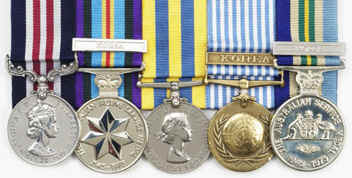 |
Brian Charles Cooper was born
in East Perth, WA, in August 1933, and was a painter before enlisting in
the Australian Army as an eighteen year old in 1951.
With the service
number 5/2053, he served in Korea with 2 RAR during 1953-54. |
| In July 1953,
holding the rank of temporary sergeant, he received an immediate award of
the Military Medal for his gallantry and leadership at Hill 111, a
position protecting the Australian lines at 'the Hook', near the Imjin
River in North Korea. After service in Korea, Brian Cooper remained in the
Army until 1968, reaching the rank of Warrant Officer Class I, and was
later prominent in the Western Australian RSL.
The recommendation for the
award of the Military Medal reads as follows: 'On the night 24/25 Jul 53
Sergeant COOPER was commanding the 2nd Battalion, The Royal Australian
Regiment Medium Machine Gun Section of ten men on Hill 111, a feature on
the extreme right flank of the United States 1st Marine Division. The task
of this section was to cover the western approaches to the HOOK feature,
some thousand yards away. At about 2130 hours a heavy enemy artillery
concentration came down on Hill 111, causing three casualties in the
section, quickly followed by a fierce assault by an estimated enemy
company, which penetrated the main defences on the immediate left of the
section.
Sergeant COOPER, leaving his MMGs manned and laid on their
primary task, quickly organised the rest of his men into a defensive
position facing his left flank and engaged the enemy so skilfully and with
such a volume of grenades and small arms fire that they were unable, in
spite of their numbers, to penetrate his position. During the next seven
hours, Sergeant COOPER stubbornly fought off with his few remaining men
repeated attempts by the enemy to overrun his position. He also on his own
initiative called down friendly artillery fire, directing it so close to
his own and the US Marines positions that it completely prevented the
enemy from pressing home further organised attacks.
The efficiency of his
fire control was made evident the next morning by the number of enemy dead
who lay in front of the area. In addition, Sergeant COOPER continued to
pass back to his battalion, throughout the action, a constant flow of the
most valuable information concerning the situation in both his and the US
Marines area, and also personally supervised the evacuation of his
casualties to a safe area under heavy shell fire and through an area in
which parties of enemy were still moving.
Throughout the whole night
Sergeant COOPER set an outstanding example of cool, cheerful and
courageous leadership which was a splendid inspiration not only to his own
section but also to the men of the US Marines with whom he was fighting.
There is no doubt that the stubborn defence his action put up in the face
of great odds, his skill in controlling his own artillery fire and the
invaluable information he passed back were largely instrumental in
breaking up a strong enemy attack on a feature vital to the defence of the
whole HOOK area.' Image & text
from the AWM
|